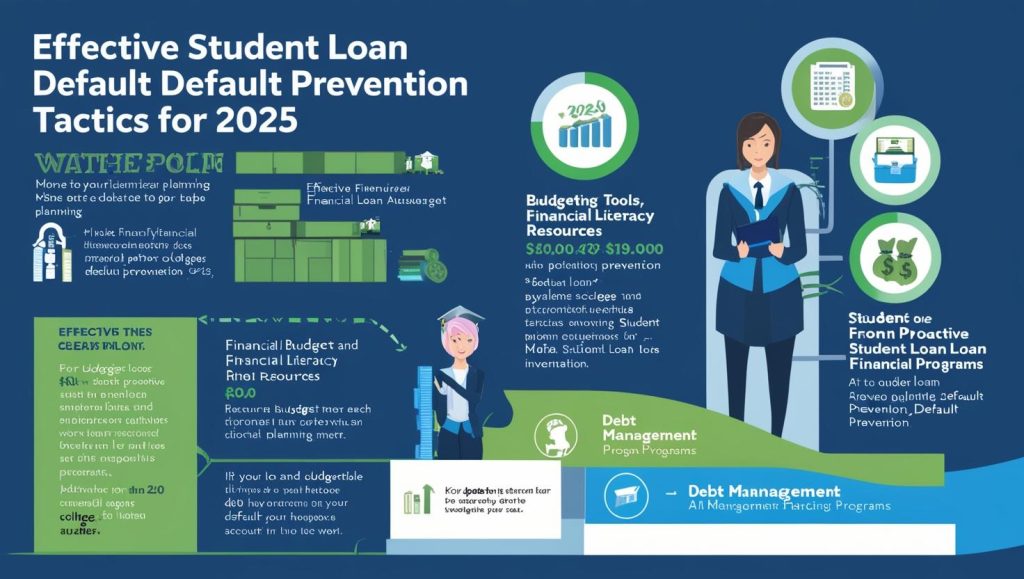Introduction
Student loan default prevention is critical for the 43 million Americans facing $1.7 trillion in debt in 2025. Rising interest rates (5%-9%) and the Trump administration’s March 2025 executive order have heightened default risks, with 10% of borrowers at risk annually. Defaulting damages credit scores and triggers aggressive collection actions, making proactive tactics essential. At US Loan Relief Now, we offer this comprehensive guide to student loan default prevention tactics in 2025—empowering you to stay on track and safeguard your finances. Let’s begin!

Why Default Prevention Matters in 2025
Default occurs after 270 days of missed payments, affecting 1.5 million borrowers yearly. The Biden administration’s $183.6 billion forgiveness efforts contrast with Trump’s tightened eligibility, leaving 15% of borrowers vulnerable. A 2024 Consumer Financial Protection Bureau report notes defaults cost $10,000+ in penalties per borrower. In 2025, with economic uncertainty and rate hikes looming, student loan default prevention tactics are crucial to avoid lifelong financial setbacks. For official stats, visit the Consumer Financial Protection Bureau.
Section 1: Assessing Your Default Risk
Step 1: Review Payment History
Log into StudentAid.gov or your servicer portal (e.g., Nelnet). Check:
- Payments Made: Last 12 months.
- Due Dates: Upcoming deadlines.
- Balance: Total owed (e.g., $35,000). Example: Missing 2 payments on $20,000 at 6% risks $2,000 in fees—act early.
Step 2: Evaluate Financial Health
Assess income vs. expenses. Example:
- Income: $3,000/month.
- Expenses: $2,600 (rent, food).
- Surplus: $400—allocate $300 to loans. 2025 Tip: 20% of borrowers face income drops—budget wisely.
Step 3: Identify Warning Signs
Late notices, servicer calls, declining credit score (below 620). Action: Contact servicer within 90 days of missed payment.
Section 2: Proactive Prevention Tactics
Step 4: Request Deferment or Forbearance
Deferment: Pauses payments (e.g., unemployment—up to 36 months). Forbearance: Temporary relief (e.g., 12 months, interest accrues). How: Apply at StudentAid.gov—submit docs (e.g., job loss proof). 2025 Note: Limits tightened—apply before April.
Step 5: Switch to Income-Driven Repayment (IDR)
IDR adjusts payments to 10%-20% of income. Example:
- $40,000 income, $50,000 loan: $300/month vs. $500 standard. Savings: Avoids default, forgiveness after 20-25 years. 2025 Update: SAVE plan delays—use PAYE.
Step 6: Consolidate to Simplify Payments
Direct Consolidation Loan merges federal loans. Benefits:
- One payment ($400/month vs. $600 across 2 loans).
- Extends terms (10-30 years). How: StudentAid.gov—30-minute process. 2025 Insight: 25% reduce default risk this way.
Step 7: Negotiate Payment Plans
Call servicers (e.g., MOHELA) for hardship plans. Success rate: 15%. Example: $200/month vs. $400 during tough times.
Section 3: Long-Term Prevention Strategies
Step 8: Build a Financial Buffer
Save $1,000-$3,000 for emergencies—job loss risk is 15% in 2025. Plan: $50/month in a 4% savings account.
Step 9: Increase Income with Side Hustles
Tutoring: $20/hour, 10 hours/week = $800/month. Freelancing: Upwork ($15/hour) = $600/month. Savings: $500 extra on $25,000 at 5% avoids default.
Step 10: Use Budgeting Tools
Apps like Mint track $40,000 at 5% ($167/month). Features:
- Alerts for due dates.
- Cuts $200/month (e.g., subscriptions). Example: $300 extra/month clears $30,000 in 7 years.
Student Loan Budgeting Tips in 2025
Step 11: Seek Counseling
Nonprofit counselors (e.g., National Foundation for Credit Counseling) offer free advice. Benefits: 30% avoid default with guidance. 2025 Tip: Verify with StudentAid.gov to avoid scams.
Section 4: Legal and Policy Considerations
Step 12: Understand Default Consequences
Wage garnishment (15%), tax refund seizure, credit score drop (100+ points). Action: Act before 270 days.
Step 13: Leverage Rehabilitation
Rehab plan: 9 payments at $50+/month resets default. Savings: Avoids collections. How: Contact servicer—90-day window.
Step 14: Stay Informed on 2025 Policies
PSLF limits, forbearance caps, relief extensions—monitor US Loan Relief Now.
Section 5: Real-Life Success Stories
- Lisa’s Turnaround: Used IDR for $45,000—avoided default.
- Tom’s Recovery: Rehabilitated $20,000 loan, restored credit.
Conclusion
Implementing student loan default prevention tactics in 2025 safeguards your finances. US Loan Relief Now is here to guide you—take action today!
